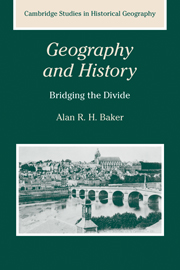Book contents
- Frontmatter
- Contents
- List of figures
- Preface
- 1 On the relations of geography and history
- 2 Locational geographies and histories
- 3 Environmental geographies and histories
- 4 Landscape geographies and histories
- 5 Regional geographies and histories
- 6 Reflections
- References
- Index
- Cambridge Studies in Historical Geography
3 - Environmental geographies and histories
Published online by Cambridge University Press: 14 January 2010
- Frontmatter
- Contents
- List of figures
- Preface
- 1 On the relations of geography and history
- 2 Locational geographies and histories
- 3 Environmental geographies and histories
- 4 Landscape geographies and histories
- 5 Regional geographies and histories
- 6 Reflections
- References
- Index
- Cambridge Studies in Historical Geography
Summary
The environmental discourse in geography
Studies of the earth as the home of humanity have for centuries been a major concern of geography. The differential encounters of peoples with their physical environments, of ‘cultures’ with ‘nature’ as well as with other ‘cultures’, have intrigued generations of geographers and underpinned legions of geographical studies.
Such enquiries have taken varied forms. First, there have been studies investigating the physical, ‘natural’, environment as an intrinsically interesting problem, whether those environments have been actual or merely potential places for human settlement. Geomorphologists, climatologists and biogeographers have focused their researches on specific aspects of physical environments while recognising that their chosen topics are but part of a general environmental system. To purist physical geographers, of course, human activity is but one of many processes at work shaping physical structures over time, merely one ‘character’ in their dramatic, narrative, historical physical geographies. Secondly, there have been studies focusing explicitly on the interactions between people and their physical environments, examining both the impact of physical environments upon human activities and attitudes, and the impress of those ideas and actions upon physical environments. Thirdly, there have been studies conducted under the flag of ‘human ecology’ which have played down the role of the physical environment, privileging instead the interactions between social groups but doing so using concepts borrowed from biogeography specifically and from ecology generally.
- Type
- Chapter
- Information
- Geography and HistoryBridging the Divide, pp. 72 - 108Publisher: Cambridge University PressPrint publication year: 2003



